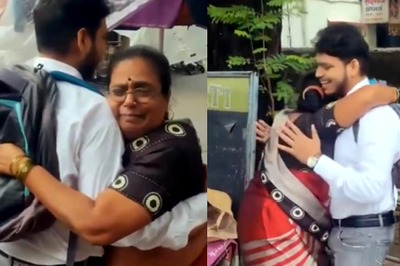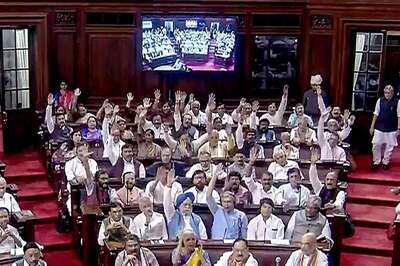
views
He started with 500 children at his mutt. Today, seven lakh-plus students who studied there are doctors, lawyers and engineers. That was what Shivakumara Swami had dedicated his life to - the education of the poor and the marginalised. There was no bar based on caste, creed or religion.
He earned the sobriquet of 'Nadedaduva Devaru' or 'Walking God' for his pioneering social, educational and philanthropic activities spread over eight decades and was an embodiment of Basava Tatva’s two primary qualities - ‘Kayaka’ or work and ‘dasoha’ or duty.
He would start his day at 4 am, because Basava believed you should always work for your living and never live on another’s earning. Secondly, whatever you earned, keep what you need for a simple life, the rest has to be given back to society, it is not ‘daana’ or charity, it is ‘dasoha’.
For 80 years, he collected ‘Dasoha’ from others and used it for poor people.
I’m not a religious person, but when I first met Swamiji more than a decade ago as officer in charge of developing the Kudalasangama Kshetra (the pilgrim centre of the Lingayats, where the 12th century saint Basaveshwara grew up), there was something about his sincerity, his personality and his aura that stuck me.
He was a very learned man - he listened intently and spoke less. After nearly one and half hours of listening to our plans on restoration of the temple, he told us three things -- one, that simply rebuilding a temple or a set of gardens won’t work, what we need is a library with the best collection. That if we couldn’t find some books of Basavanna’s, we should even access photocopies of them and keep them in the library.
Second, that there must be a place for people to come and do some service or ‘kayaka’ - so we reserved 200 acres for this. Thirdly, ‘dasoha.’ That everyone who comes there must get free food. So we made arrangements where nearly 2,000 people can come and eat, and even today, clean, hygenic food is served just as it has been served for the thousands of kids at his mutt every day.
His mutt is more like a monastery. There are nearly 9,000 children who study in the Siddaganga institutions every year. And he gives free accommodation, free food and free education. The hostels he has built look like buildings in the North Block, and how do you think free food is provided?
Decades ago, he would go around asking people to donate rice or grains or vegetables. At that time, this was a small mutt. Most of the development (of 100-plus educational institutions) has happened during Swamiji’s lifetime. Once it became a routine and people realised what he promised and what he did at the mutt, they started giving food grains and other essentials every day willingly.
Today, if these 9000 children are fed, it is because villages around the mutt have organised themselves into providing for them. There are around 3,000 villages around here - Tumkur, Hassan and Bangalore (rural) districts. Everyday three villages send truck-loads of supplies - like vegetables and foodgrains and oil - to the mutt to be delivered in the mornings.
Different dates are fixed for different villages by people themselves. They give out of love, it has become a routine for them. And people of all religions, all castes give. Such was his aura and the respect they have for him.
He started his day with a prayer at 4am to his ‘ishta linga,’ a small areca-sized linga held in his palm. He prayed for an hour thrice a day and though there were half a dozen temples within the mutt premises - ancient ones, more than 500 years old - he never felt the need to go there and pray.
He did not disrespect the temples, but for him, his god was in his palm, his heart. The linga icon too was just an emblem used for concentration. There is no temple, no archaka (priest), no mediator between him and God. He lived by that until his last breath.
And he has done this day in and day out for 111 years. He was ordained (to become a monk at the mutt) by the age of 25, and he lived by these principles, shown to the world by his actions. He has never discriminated between religions and castes, and never gone by such Vedic norms of impurity of women during menstruation. Women are equal in all respects, and his mutt was open to children of all castes.
He was progressive, and while other religious seers may have wanted to forward their religion, he considered humanism more important than religion. Today, when I heard about his demise, I couldn’t control my tears. But I’m glad that even in his death, people are talking about what he did and what he lived for. Even in death, he is spreading Lingayat ideals further.
At a time when seers made their political inclinations clear, he was one seer known for never taking sides with any political party. He wielded considerable political influence that made leaders from all parties flock to his mutt, 70 km from Bengaluru, to seek his support and advice over decades. Today too, all politicians are there, but he never sided with anyone.
Politicians would go seek his blessings because they thought they would get votes that way, but he never took sides.
When the separate religion status for Lingayats became an issue, he realised it took political overtones. So all he said was, it doesn’t matter whether government gives (the religion tag) or not.
That’s was the secret of his life. No religion, no caste, no politics, only humanity.
(SM Jamdar is a retired IAS officer and Lingayat scholar)
(As told to Deepa Balakrishnan)


















Comments
0 comment